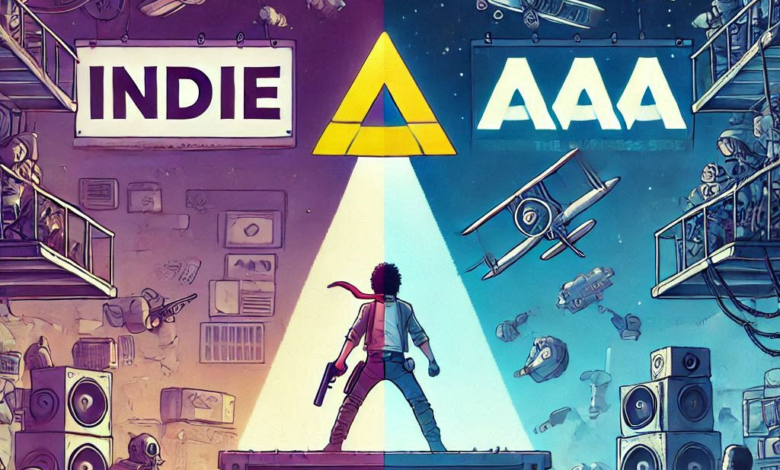Indie vs. AAA: Understanding the Business Side of Game Development in 2025

The next game in 2025 shows a vivid, ever-changing space where different business models, challenges, technologies, and opportunities are faced by game developers. In the current gaming market that is highly competitive, knowing the differences in production, financing, marketing, and ultimately, long-term viability is crucial for developers, investors, and gamers. Whether it occurs in an indie game development team on a passion project or a game development company seeking the next blockbuster, their strategies are quite different, but both of them somehow enhance the industry’s ecosystem.
- The Defining Characteristics of Indie and AAA Game Development
Indie game developers often team up with a group of individuals with limited funds which may be sourced from the general public, private savings or smaller investors. The attractiveness of indie development is in its ability to think out of the box – developers can experiment with novel gameplay mechanics, visual styles, and story presentation that would normally not be approved for a big AAA project. Names like Hollow Knight, Hades, and Celeste are the best examples of indie games that have established themselves in the market both positively and commercially while not having much financial help.
On the contrary, AAA game development is a term used to describe huge-scale projects that are created by major game design companies with budgets that usually go way beyond a couple of hundreds of millions of dollars. These games are made for everyone and they generally include teams of artists and developers with high-quality visual effects, extensive content, and large-scale marketing campaigns. Brands such as Call of Duty, Assassin’s Creed, and The Witcher are sorted under them. Due to the significant investment necessary, AAA studios confront strong pressure that forces them to be innovative and think of paths to make their businesses profitable such as the introduction of microtransactions, season passes, and live-service models.
- Funding and Financial Models
The way money comes into play in the game industry has been changing a lot over the past few years. Indie developers often find creative ways to raise money. Crowdfund sites like Kickstarter and Patreon have given rise to a great number of indie studios that could raise money from their communities. In addition, they can use government grants, sign a contract with a publisher, or even sell their games through a platform like Steam on an early basis. However, there are still financial risks involved, as when a small team fails to launch, it can lead to the end of the funding.
On the other hand, large companies have very easy ways of raising finance such as through parent corporations or publishers. These companies are also in the best position to exploit the benefits of things like pre-ordering, marketing tie-ins, and merchandising. However, due to the increase in the production cost of games, the big companies are also feeling the creak. The gaming space in recent years has seen a lot of layoffs and studio closures, even the well-known series are being forced to do something new so as to stand out in a very competitive market.
- Production Timelines and Development Cycles
The difference that very much stands out in indie and AAA game development is the time and complexity of their production processes. Indie games mostly have shorter development cycles, from one to five years, depending on the scope of the game, and of course, the size of the team. This also promotes operational flexibility as the small teams can easily adapt and switch to trends to meet customer needs. Similarly, indie developers are releasing early access games as a way to gather player feedback and fine-tune their games before their official launch.
AAA games are quite an advanced project because they have enormous pre-production, which is the beginning of the production process, production itself, and, finally, post-launch support. Conversely, the development periods usually last from five to eight years, with a team of hundreds of developers (and sometimes even thousands) working in different parts of the loaded roles. Adding high-quality light effects and graphic textures, creative puzzles and obstacles, and a glitch-free online component hugely blow out the deadlines as a result. In addition, AAA games depend on post-launch support, which includes content like the downloadable downloadable DLC, fixing bugs, and new and regular content updates to stay involved in the game of work.
Marketing Strategies and Audience Reach
Marketing is the differentiating factor between AAA and indie games. Indie game developers generally have low marketing budgets and have to employ guerilla tactics, social media, and the word of the mouth method to get their projects noticed. Livestreaming platforms such as Twitch and YouTube have been the main marketing tools. Indie game developers have collaborated with gaming influencers and their videos for quick gameplay displays to draw interest to their games. The bigger reason for success in indie games is the supportive community, not spending money on advertising.
AAA studios, on the other hand, have all the money in the world and are therefore able to afford and conduct ad campaigns on a grand scale, for example, TV commercials, online ads, and celebrity endorsements. You can also see the game trailers in popular events like E3, Gamescom, and The Game Awards. A reasonable explanation could be that these studios made partnership agreements with major console manufacturers such as Sony, Microsoft, and Nintendo, which allowed their games to be promoted on a large scale and even before the release date.
- Monetization Models and Revenue Streams
In the past ten years, there has been a great change in the way games make money. Indie developers often sell their games at a fixed price or distribute them digitally through Steam, itch.io, or the Epic Games Store, yet many of them also use alternative models. Subscription services like Xbox Game Pass and PlayStation Plus that indie developers are featured on, become by new revenue streams as a result of this being the case because the platforms have gained access to millions of players.
AAA games still remain the main domain of different ways of generating revenue. Besides the initial buying cost, many AAA titles are equipped with in-game purchases, battle passes, and premium DLC. The development of live-service games like Fortnite and Destiny 2 has shown that companies can snatch not just through traditional game sales but with the support of microtransactions. Still, the overreliance on monetization strategies has occasionally lead to customer misuse, where aggressive in-game purchases have become the norm, and players have become more and more negative about them.
- Challenges Faced by Indie and AAA Developers
Both indie and AAA developers in 2025 have distinctive pros and cons. The indie game developers often find financing and visibility to be some of the main issues in the fully congested market. The infiltration of new developers into the market by the use of AI-generated content and procedural game design tools will increase the difficulty of emerging as a unique developer. Moreover, dealing with scope creep— a typical scenario of developers including more characteristics than it was initially planned which, in turn, causes a delay of projects and overruns resources.
AAA studios have been the target of some pressures which are the result of high production costs, the demands of the players, and labor issues also. It is only recently that crunch culture—a phrase that is used to denote working for longer hours than one’s regular working hours, it is tailored to only one person—has attracted the attention of people. As a result, big studios have been forced to reconsider their project schedules. Notably, there have been more layoffs and studio closures a fact that publishers have been quick to cut costs when a project underperforms has contributed to this)
- The Future of Indie and AAA Game Development
The future of game development will undoubtedly witness both indie innovation and multi-billion dollar extravagant projects. The industry’s creative potential has increased with the Unity and Unreal Engine 5 engines which empower indie developers to create visually stunning games that can match up to AAA productions. Furthermore, AI-driven tools are being utilized by small teams to optimize workflows, automate repetitive tasks and improve procedural content generation.
Future years of development for AAA studios will be a matter of working within the limits of financial sustainability and player expectations. Games-as-a-service (GaaS) models are going to be around for a long time, but developers need to come up with new ideas to prevent users from uninstalling games due to heavy monetization trends. Subscriptions gaming alongside cloud gaming is also likely to be key elements, thus changing the distribution and consumption of games.
- Final Thoughts
As far as the gaming industry is concerned, the so-called the future of game development will be quite different. Indie game developers introduce brand new ideas, the freedom of art, and the implementation of innovative game mechanics that go beyond the limits. In the meantime, AAA studios not only represent the primary element of high-quality content but also the blockbuster experiences, expansive worlds, and, therefore, the very success of the industry. As the gaming environment continues to transform in 2025, the sectors will cope with novel challenges and opportunities and in the outcome, they will empower the future of interactive entertainment by these difficulties or changes. Whether you’re an aspiring developer, an investor, or a passionate gamer, understanding the business side of game development is essential for navigating this ever-changing industry.



